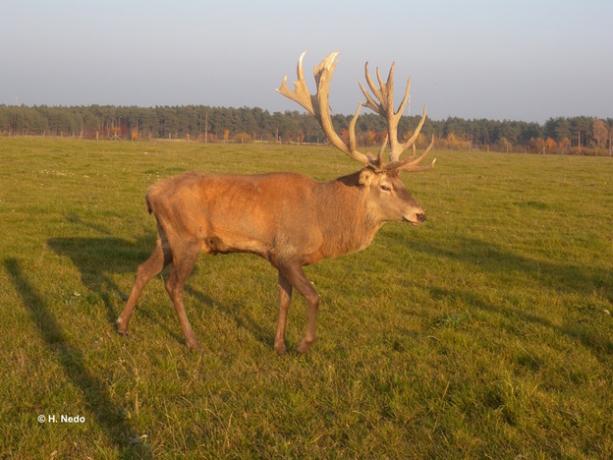Distinguish between red deer and fallow deer
Red deer and fallow deer live in European forests as large species of deer. You can easily distinguish the animals from a few distinctive features.
The deer family (Cervidae) is an even-toed ungulate, just like wild boar. Since their claws are in the language The hunters are referred to as shells, these game species are also called hoofed game. The most common deer species living in German forests are the smaller roe deer (Capreolus capreolus), the fallow deer (Dama dama) and the red deer (Cervus elaphus).
Fallow deer - shovel antlers and light spots typical
Roe deer, fallow deer and red deer differ in the type of antlers that the males carry. The roebuck is well known with its short antlers. In the red deer this is much larger and in the older animal it is branched several times. The hunter speaks of a twelve-ender when it has twelve points. These trophies can be seen often.
A fallow deer's antlers are shovel antlers. At the top it also shows several rungs. As antlers, it is slightly smaller than that of a red deer.
Fallow deer are larger than roe deer but smaller than red deer. The animals weigh between 65 and 100 kilograms, while deer weigh up to 30 kilograms. Their physique is similar to that of the red deer, although they have a shorter neck and shorter legs.
In summer the coat is typically light, almost white, on the belly and the inside of the legs, and reddish-brown on the upper side. A dark stripe, the so-called eel line, runs directly on the back. It is accompanied by white spots on the right and left.
Anyone who meets deer in a wildlife park, zoo or in the forest with children will mostly ...
The fur of the fallow deer can be different depending on the occurrence and the individual. In winter, the entire fur becomes darker.

Even if the summer color has disappeared, the fallow deer still has a distinctive distinguishing feature: it is the mirror. This refers to the back of the thighs, i.e. the side of the tail. This area is very bright even in winter. The tail, constantly moving, is clearly visible. A dark hairline also stands out on the tail and around the mirror.

Red deer - majestically large
The largest animal species in Germany's forests is the red deer. Various information can be found about the possible weight of the deer, depending on the source. They vary between 100 and 300 kilograms, with age and season playing a major role. On average, it is 110 kilograms. The males are larger than the hinds.
Externally, the considerable antlers of the male animals are their clearest distinguishing feature. The color of the fur is monochrome brown or gray-brown, depending on the season. In summer it shines hazel brown. The legs of the deer are slender and long and the neck is much narrower and longer than that of the fallow deer.
Red deer look less stocky. They are elegant animals. In red deer, too, the mirror is lighter in color than the rest of the fur. However, the contrast is not as clear as in fallow deer.
Only young calves have white spots in the fur of red deer. They disappear in adult animals. During the rutting season in autumn, the males form a mane around the neck. Then their antlers are fully grown and the animals fight for the privilege of being able to mate with the cows. After the mating season in winter, the antlers are shed.

The two types of deer can be easily distinguished based on the characteristics mentioned. Fallow deer are not quite as shy as red deer. It also spends time in a park-like landscape. This makes it easier for you to see it in the wild.
When the game species are protected from hunting by their closed seasons, they become less shy. When the red deer rutting characterizes their behavior in October and November, they lose their caution and let their rutting sounds and behavior be heard and observed in the forest.

